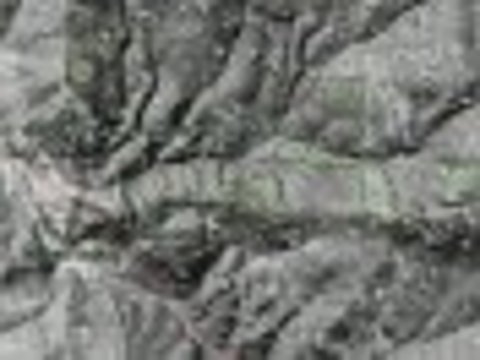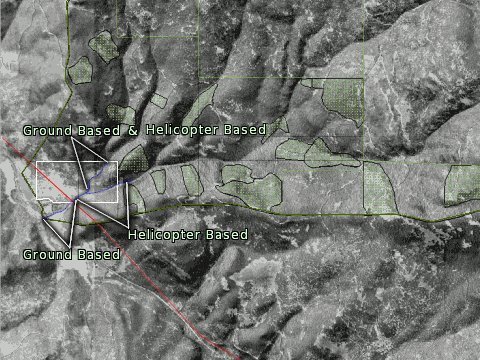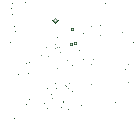~~* The Singing Falls Stream Restoration Project *~~
 ϕ
ϕ
~~* Project Implementation Phase-LWD and Helicopters *~~
Image Gallery Link Located Below Text
Aquatic Habitat Restoration-Cultivating the Domestic/Wilderness Interface
After a lengthy process of analysis, design and the staging of habitat building materials, the time of actual implementation began.
If you place your cursor over the small thumbnail image you will see a 3d view of the project site area. The red line shows the right of way for the secondary power line passing through the lower forty acres of the ranch. The white outline is the basic outline of the singing falls property.
Two methods of materials distribution and placement where decided upon. Ground Based placement and Helicopter Based placement. Helicopter based log placement is faster and less precise than ground based structure building.
This section of the site covers the air based placement of logs.
The work “Chinook” is native american in origin. Specifically it is the name of a NW USA tribal people group. The helicopter thus named gained its popularity during the Viet Nam war era where is was used to speedily transport warriors and supplies from place to place.
The Columbia Helicopter Company has taken this technology and is now using it in various types civilian applications. One of which is the aquatic habitat restoration work being done in the Umpqua National Forest. This is the ideal tool for moving large inaccessible wood to remote streams needing restoration work. Many of these areas were logged 50 or 60 years ago. Some of the roads surrounding these areas have been decommissioned. Helicopter is the way to get the job done.
In a couple of the images in the gallery you will notice a large bubble protruding from each side of the helicopter's pilot seat. They are part of a technique of load transport and placement. This method is a unique practice of operation called “Direct Visual Operational Control or (DVOC)”. This method as well as the company's long successful history is described at their site.
I have had the opportunity to meet several people and crew members from the company. They are great folks with well tuned skill sets and a good track record. There is no hesitation on my part to recommend them for this type of work.

 Project site in 3D
Project site in 3D
Why this method seemingly extravagant method of placement? It is true that most restoration work will be ground based. But In spite of the high price tag associated with helicopter flight time, it is measures less expensive and more efficient that ground based log placement tasks of the size and location of our project. All tolled there were 160 plus logs to be distributed in the riparian zone. Several of these sites have very difficult access paths. Fortunately the USFS was doing stream restoration in an area not far from here. Ground based operations would have been made considerably more expensive and of greater adverse impact to the riparian zone because of the difficult access.
The table cell on the left below will lead you to a gallery of images related to our large wood air placement phase of the project. If you have sufficient band width or patience there is an mp3 video linked from the first place of the gallery. It is approximately 28 megabytes in size but well worth the viewing in my opinion if you want an observers perspective on helicopter instream placement work.
Click on the link to access the gallery.
| Helicopter Based Large Wood Placement Image Gallery | Free Restoration Guidelines |

Helicopters for Habitat
stream index
top






